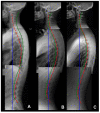Improved Pain and Quality of Life with Corrected Thoracic and Lumbosacral Spondylolisthesis Subluxations Using CBP®: A Case Study and 1-Year Follow-Up
- PMID: 35586358
- PMCID: PMC9063820
- DOI: 10.3941/jrcr.v16i2.4413
Improved Pain and Quality of Life with Corrected Thoracic and Lumbosacral Spondylolisthesis Subluxations Using CBP®: A Case Study and 1-Year Follow-Up
Abstract
Objective: Discuss non-surgical spinal rehabilitation for a 27-year-old male with thoracic and lumbosacral spondylolistheses. A selective literature review and discussion are provided.
Clinical features: A 27-year-old male presented with severe, 8/10 mid and low back pain. Initial lateral thoracic and lumbar x-rays revealed grade 1 spondylolistheses at T9-T10 and L5-S1 measuring -5.3 mm and -6.8 mm.
Interventions and outcomes: The patient completed 60 sessions of Mirror Image® spinal adjustments, exercises, and traction over 30 weeks. Post-treatment x-rays showed correction in translations at T9-T10 and L5-S1 from -5.3 mm to 0.0 mm and -6.8 mm to -1.0 mm, within normal limits. 1-year follow-up x-rays showed maintained correction.
Conclusions: This case is the first documented evidence of non-surgical or chiropractic treatment for thoracic and lumbosacral spondylolistheses where spinal alignment was corrected. More research is needed to investigate the clinical implications and applications.
Keywords: Chiropractic BioPhysics; Lumbosacral spondylolisthesis; Mirror Image; Spinal Adjustments; Spinal Rehabilitation; Spinal Traction; Thoracic spondylolisthesis; sagittal spinal alignment; sagittal spinal balance; thoracic spine alignment.
Copyright Journal of Radiology Case Reports.
Figures




References
-
- Morningstar M, Pettibon BR, Remz Cl. The Pettibon System: A Neurophysiologic Approach to Spine and Posture Correction. 2006
-
- Jackson BL, Harrison DD, Robertson GA, Barker WF. Chiropractic Biophysics Lateral Cervical Film Analysis. J Manipulative Physiol Ther. 1993;16(6):384–91. - PubMed
-
- Troyanovich SJ, Robertson GA, Harrison DD, Holland B. Intra- and Interexaminer Reliability of the Chiropractic Biophysics Lateral Lumbar Radiographic Mensuration Procedure. J Manipulative Physiol Ther. 1995;18(8):519–24. - PubMed
Publication types
MeSH terms
LinkOut - more resources
Full Text Sources
Medical
Research Materials

